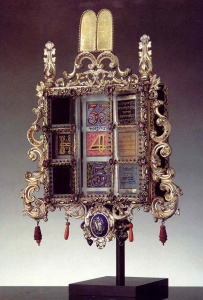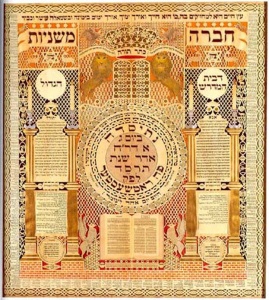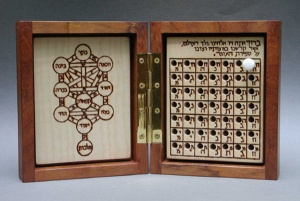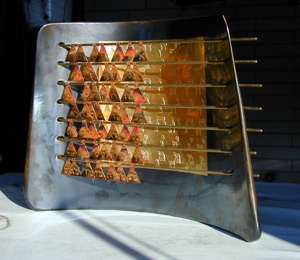Counting
Anticipation is a powerful emotion indeed! When we count the omer, we are anticipating the holiday of Shavous and the re-enactment of receiving the Torah. We count each day, knowing full well that on the next day we will count again until forty-nine. We are confident as to where we are going, knowing that anticipation is a form of faith. Counting for observant Jews is really an act of devotion. We cherish each and every day that spans our trek from the constraints of Egyptian slavery to our liberation at Har Sinai. As an expression of hiddur mitzvah Jewish artists make omer counters to guide our way along this path of devotion.

The impressive and joyful Omer Calendar made by Maurice Mayer, a French artist, around 1870 gives us a visual focus as we make the brocha and count each day. The elaborate box is decorated in rococo swirls and is topped by the Ten Commandments and palm branches reminiscent of the aron kodesh in the Rue de la Victoire Synagogue in Paris. Along the left side are the Sephardic designations for each row. An “H” marks the top row that designates “homer” in Ladino for the daily omer count. “S” should occupy the middle row, designating the week or “semanas” of the count. And finally “D” stands for “dias” or the day of the specific week. Although these details have been lost or rearranged in this artwork, the overall effect of the careful workmanship and loving attention to detail allows us to see how important the counting was to the owner of this object. Each succeeding day becomes a specific visual delight as a newly decorated number advances the omer, the week and the day of the week.

The Memorial Plaque and Omer Calendar for Hevrah Mishnayyot, created by Baruch Zvi Ring in 1904 for his synagogue in Rochester, New York is a masterpiece of Jewish folk art. This very large papercut measuring 55 inches by 50 inches embeds the mitzvah of the public omer counting each night in the larger context of a Mishnah study society. Along the edges of this papercut are close to two hundred and fifty names of deceased members of the congregation whose memory is honored by the Mishnah study of the Hevrah. Between each of the candlesticks is the kaddish d’rabbonim and anah, haShem moleh rachamim, each said after Mishnah study for the deceased. In the center of the papercut is the declaration that the “Hevrah Mishnayyot of the Beth Midrash Hagadol was established here in Rochester on Tuesday, the first day of Rosh Hodesh Adar in 5664.” This is surrounded by the blessing for counting the omer and forty-eight circles traveling clockwise specifying each day’s count. Not surprisingly, the Ten Commandments, flanked by two protective lions and finally the crown of Torah prevails over the mitzvah of sefiros ha’ omer. The crown of Torah, itself divided into Keter Torah, Keter Kachunah, and Keter Malchus is guarded by two American eagles and finally punctuated by five stars of David emblazoned with the word Zion. The incredible workmanship and patience that was necessary to create this papercut stands as an everlasting memorial to the artist and the Hevrah that sought to link the counting of the omer and its faithful memory of those who have gone before. Here we see the omer count in living relationship to continual Torah study and the communal life of our people. It is almost as if the Hevrah was petitioning God and saying; “If we remember to dutifully and carefully count in anticipation of receiving Your Torah, we ask You to remember these neshamahs so they should merit an aliyah in the world above.”

Arnold Schwarzbart, a contemporary Judaic artist of ritual objects, has given us a completely different understanding of counting the omer. For him, the meditations on the forty-nine sefirot, the Kabalistic ascent out of bondage to revelation, was the motivating factor to make omer counters. We can immediately see in his box-like omer counter the sefirah tree that embodies the ten sefirot, the divine manifestations of God, opposite the forty-nine peg holes with which to advance the omer count. We notice that our counting is, by its very nature, incomplete because it lacks three of the highest manifestations of God; Binah, Chochmah, and Keter Elyon. As we count each day and plug in to the specific sefirah; hesid s’behesid, gevorah s’behesid and so on down the first row and then up to the top of the next and down again, we understand that the counting is a process of discovery of different aspects of God as He descends, as it were, to our earthly realm. Traversing Schwarzbart’s chart, starting at the top and ending at the lower left corner, each attribute is modified by the other sefirot day to day until we reach malchus s’bemalchus, God’s lowest manifestation and yet for us the supreme revelation. On the forty-ninth day God is manifestly King over the whole world and ready to give us the Torah. Once complete we close the silver on black enamel box cover and view a simultaneous vision of the parting of the sea and the giving of the Law, the beginning and end of our journey.

Schwarzbart’s ceramic Omer counter approaches the task before us in yet another provocative way. This simple curved glazed ceramic slab, suggestive of Har Sinai, supports seven horizontal bronze rods. Each rod, a physical symbol of one week, bears seven movable copper triangles, marking each day. On the rear wall of the ceramic slab is a gold leaf square with each day’s sefirah marked out in low relief. On the first day of Passover all the copper tabs are arranged on the left side of the rods. Day by day, one by one, as we count the omer, they are moved to the right to visually correspond with the sefirah on the gold leaf plaque behind them. Finally, on the day before Shavous, they are now all properly aligned on the bronze rods, only inches from their original position. Amazing similar to a Chinese abacus, Schwarzbart has created a celestial calculator, an accumulation of days, of brochos and sefirot that are, visually speaking, no less than a transfer from heaven. If we have meditated each day on the forty-nine permutations of the Divine sefirot, we have moved physically almost imperceptibly, and yet we have been transformed into a people ready to receive the Torah.
By virtue of its artwork and creativity each of these omer counters has elevated the simple anticipation of Shavous into a love for each day on our journey. We can appreciate the omer counter for its singular beauty day by day, or as an opportunity for us to reflect on service to the Jewish people. Optimally it even directs us towards a deeply spiritual process and appreciation of the Divine revelation. One thing is for sure; these works of art tell us that the counting of the omer is always more than a simple counting of days.